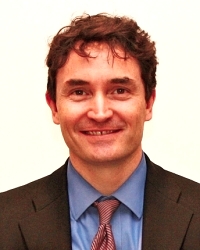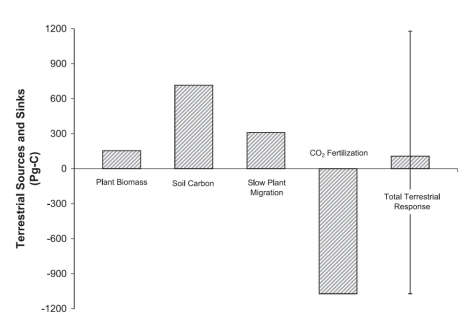Carbon conundrum could push firmer emission action
November 24, 2012 — andyextance

Measuring CO2 emitted by soil in tropical forests from tree debris with a particular chemical signature, with a wire mesh tent excluding other tree debris. Climate change could enhance tree growth in tropical forests, and the resulting increase in litterfall could stimulate soil micro-organisms leading to a release of stored soil carbon. Such uncertainties in the carbon cycle aren’t well captured by climate models. Credit: Dr. Emma Sayer
Rather than sucking up ever more of the greenhouse gas CO2 as the world warms, plants and soil could begin releasing it instead. This hasn’t been included in climate models, and means their predictions of the temperature rise following us burning more fossil fuels might be too low. That’s what US researchers have found after linking two models, one simulating climate and the other the ‘carbon cycle’ moving through living creatures and the environment. “That means that to keep concentrations of CO2 in the atmosphere at ’safe’ levels, we might have to reduce our emissions more aggressively than we currently realise,” said Paul Higgins from the American Meteorological Society in Washington DC.
Plants take up CO2 to power their growth through photosynthesis. Many climate models that consider the carbon cycle assume that more CO2 in the air will speed their growth, and mean they absorb the gas faster. But when Paul looked at what plants actually did during his master’s degree at Stanford University, California, more than a decade ago he found this ‘CO2 fertilisation’ didn’t always happen. “Carbon cycle models did tend to make an optimistic assumption about CO2 enrichment that was not entirely consistent with what the experiments were suggesting,” he told me.
That thought stayed in Paul’s mind as he continued his research, which brought him to John Harte’s labs at University of California, Berkeley, in 2003. There he found that plants faced limits on how readily they can move to places where conditions suit them best as climate changes. That can also affect how much CO2 they store overall, he noted. “Over the next couple of years, I kept going back to that and thinking ‘Why don’t we think about CO2 enrichment in the context of this work as well?’”
Overturning old turf

Paul Higgins from the American Meteorological Society has shown how uncertain changes in the carbon cycle can make climate models, but underlines that this makes acting more important. Credit: American Meteorological Society
Paul and John therefore looked at how these effects would combine to impact how much CO2 plants and soil can store. To do this, they used a climate model that simulated processes in the atmosphere and ocean, and used its output to feed a model of the world’s ecosystems. But rather than using the models to make predictions and then test how uncertain they are, they set out to measure the uncertainties from the start. “We almost had to break the model to make it test uncertainty around these issues,” Paul said. “We’re separating them in a way that allows you to look independently at factors that can mask one another, so you can distinguish what is causing carbon changes. It’s very powerful as an experimental tool but, if you’re trying to project what is going to happen at the end of this century, you wouldn’t do that.”
The scientists looked at four different scenarios for the time period 2080-2100, in a research paper published in the Journal of Climate this month. One ‘control’ scenario kept CO2 steady at levels from before industry started spreading across the world, while the other three were based on a fossil fuel-intensive future. In those three cases atmospheric CO2 levels increase to 925 parts per million (ppm) by 2100, compared to 391 ppm today, and temperatures rise by 1-11°C, with an average of 5.3°C. In one of those scenarios, they kept the idea of CO2 fertilisation. But, thanks to the separate ecosystem and climate models, they create another where CO2 warms the world but doesn’t affect plant growth. “This paper is essentially saying, ‘We really don’t know how CO2 fertilisation is going to play out at this global scale,” Paul explained. “So, let’s do some simulations in which we have CO2 fertilisation turned on and some in which it’s turned off – where we hold CO2 concentrations that the plants ‘see’ at 350 parts per million CO2. Then we’ll get a sense of how important CO2 fertilisation is.”
In the final scenario Paul and John kept CO2 fertilisation, but limited how far plants could move. “Within the carbon model you have grid boxes throughout the world where different types of plants grow,” Paul explained. “Normally the model would say it just depends on the climate whether that plant type will grow. We only let plants that were in a grid box or one of its neighbours under control conditions grow.”
Planting uncertainty, not doubt
Those experiments showed that these assumptions about plant and soil behaviour could make huge differences to climate model outcomes. When carbon fertilisation was turned ‘off’, plants and soils released an extra 800 million tonnes of carbon, more than the amount of carbon currently contained in the atmosphere. Over the same 20-year period, limiting plant movement released an extra 300 million tonnes of carbon. That’s roughly the same as all humans have released by burning fossil fuels and producing cement from the beginning of the industrial revolution to today. With carbon fertilisation turned ‘on’ in the future scenarios of climate change it pulled over a trillion tonnes of extra carbon from the atmosphere than in the control run.

Carbon emissions (positive numbers) and uptake (negative numbers) between 2080 and 2100 under the fossil-fuel intensive A1F1 warming scenario. PgC means petagrams of carbon emissions, with 1 PgC being the same as a billion tonnes of carbon emitted. The left hand two bars show carbon emitted from soils and plants, which Paul and John found from the difference between the prediction run with carbon fertilisation turned off and the control run. The third bar from the left shows extra carbon emitted in the prediction run when plants aren’t free to move wherever they want. The fourth bar from the left shows carbon absorbed when CO2 fertilisation is turned on. The right hand bar shows the net result when all these effects are added together, and the narrow black bar shows the wide range of uncertainty that could be achieved by adding them in different combinations. © American Meteorological Society. Used with permission.
Taken together, these values mean the amount of carbon in the atmosphere in the model depends strongly on the carbon cycle. Whether plants can move and CO2 fertilisation happens or not, it could increase or decrease by extremes of over a trillion tonnes. That full range means that predictions of how much greenhouse gas humans can ‘safely’ emit become extremely uncertain. Therefore, the most optimistic scenario of human greenhouse gas emissions considered by the UN’s Intergovernmental Panel on Climate Change could lead to atmospheric levels expected under much more carbon-intensive conditions.
The most uncertain results show plants and soil could absorb more or less CO2 than models currently predict. However, Paul likened hoping for the best case scenario to driving without a seatbelt while hoping you won’t have an accident. “The very fact that what’s going to happen to you while you’re out driving is uncertain is why you buckle your seatbelt,” he said. “If you waited to buckle your seatbelt until you were sure you were going to be in an accident and need it, it would be too late and you would have managed the risk very poorly.”
Paul added that waiting for researchers to reduce model uncertainty before tackling climate change would also be unwise. “Through observations and additional experiments we might winnow down some of that uncertainty but I think some of it is a fact of life with global change,” he said. “There’s a good chance that uncertainty will increase over time, because I’m sure there are factors that we haven’t fully incorporated. Good scientific research can take uncertainty in either direction.”
Higgins, P., & Harte, J. (2012). Carbon Cycle Uncertainty Increases Climate Change Risks and Mitigation Challenges Journal of Climate, 25 (21), 7660-7668 DOI: 10.1175/JCLI-D-12-00089.1
Comments (0)
You don't have permission to comment on this page.